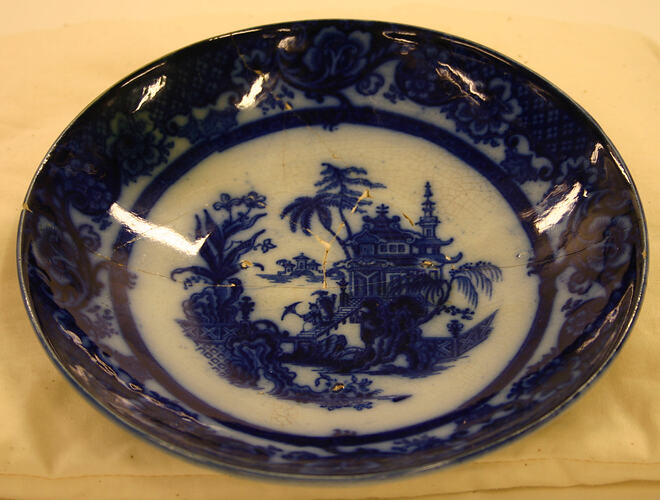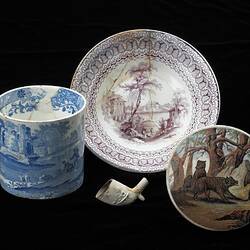Summary
This saucer, which was reconstructed from 5 pieces, was excavated at the Commonwealth Block site between 1988 and 2003. Manufacturers mark on base reads 'CHENSI' which has been attributed to John Meir, 1812 - 1836, Tunstall, Staffordshire Potteries, England.
Homewares.
Numerous crockery pieces were found all over the Little Lon site. Crockery gives us a glimpse of everyday life in Melbourne in the 1880s. In the houses around Little Lon, residents used decorated crockery. Most pieces were cheap earthenware or stoneware, yet provided colour and cheer. Only a few could afford to buy matching sets, and most china was probably acquired second-hand. Some were once expensive pieces. Householders mixed and matched their crockery from the great range of mass-produced designs available. 'Blue and white' and the 'willow' pattern, was the most popular choice and was produced by English potteries from 1790.
Physical Description
This saucer which has been reconstructed, is transfer printed blue flow ware with metal glaze. The design on upperside is a floral and geometric pattern and on the face it is scenic.
Physical Description
5 fragments of ceramic saucer. Transfer printed blue flow ware with metal glaze, blue colour AS B12 7.5 PB 2/8. Design on upperside is floral/ geometric, face is scenic. Manufacturers mark on base reads 'CHENSI' which has been attributed to John Meir, Staffordshire, between 1812 and 1836.. Design is 'CHENSI' which has been atributed to John Meir, 1812 - 1836, Tunstall Staffordshire Potteries. Supp. File has article on Flow Blue china
More Information
-
Collection Names
-
Collecting Areas
-
Acquisition Information
Transfer from Heritage Victoria, Industry Superannuation Property Trust, 03 May 2005
-
Manufacture Name
-
Manufacture Date
-
Manufacturer (Probable)
John Meir, Tunstall, Staffordshire, England, Great Britain, 1812-1836
-
Inscriptions
On base: 'CHENSI' with an elaborate border (TP).
-
Context Number
57/13
-
Site
[TCS] Australia, Victoria, Commonwealth Block, Melbourne
-
Distinguishing Marks
Manufacturers mark on base reads 'CHENSI' with an elaborate border See Gaston, Collectors Encyclopedia of Flow Blue China, p.55.
-
Activity
-
Specific Activity
-
Decoration
-
Colour
Blue
-
Moulding
Chen Si
-
Form
Plain Rim; Well Body
-
Shape
Round
-
Technique
-
Provenance
England, Staffordshire
-
Classification
-
Category
-
Discipline
-
Type of item
-
Exhibition Collection Management
175 mm (Width), 30 mm (Height)
Width = Diameter
-
References
A.W. Coysh & R.K. Henrywood 'The Dictonary of Blue & White Printed Pottery
79 Pages
-
Keywords


